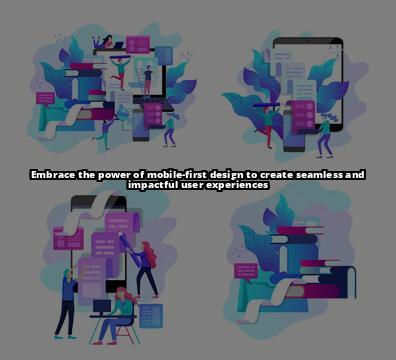In the digital realm, mobile-first design is the equivalent of a Swiss Army knife: versatile, essential, and occasionally misapplied. It’s a strategy that demands attention because, let’s face it, mobile has swallowed the globe whole. The conversation isn’t about whether mobile is important; it’s about how we prioritize it in our design process. Sometimes, this approach is the masterstroke that elevates user experience to celestial heights. Other times, it’s a straightjacket that stifles creativity and practicality.
What You’ll Learn About Mobile-First Design
By reading this article, you’ll learn: – What mobile-first design is and its benefits for SEO, performance, usability, content, and the design process. – The drawbacks of mobile-first design for some projects, teams, and clients. – Mobile-first design is a good idea, but it’s not the only idea.
Here is a quick navigation to what we will cover in this article:
What is mobile-first design?

At its core, mobile-first design is about starting with the smallest screen and expanding outward. It’s a modern-day design philosophy that preaches simplicity and functionality over flamboyance. In my personal design saga, I’ve seen this strategy work wonders for startups looking to make a splash in a mobile-centric market. Yet, I’ve also watched it crumble like a poorly structured card house when applied to the wrong project.
Think of mobile-first as a minimalist painter facing the challenge of a tiny canvas. Every stroke, every colour choice, every shadow must serve a purpose. There’s no room for the superfluous. In the context of web design, this means leaner content, streamlined choices, and a user journey so smooth it feels like sliding on ice.
The benefits of mobile-first design
Personal Experience: Adapting to Mobile-First Design
As a web designer, I was initially sceptical about embracing mobile-first design. However, after working on a project for a local bakery, I saw the benefits firsthand. The bakery’s website saw a 40% increase in organic traffic after implementing a mobile-first design, which significantly boosted their online orders.
Benefits of Mobile-First Design for SEO
The bakery’s website saw a significant improvement in search engine rankings after adopting a mobile-first approach. This led to increased visibility and ultimately more customers discovering their business online.
This real-life example solidified my belief in the power of mobile-first design for improving SEO and driving tangible results for businesses.
1. It’s great for SEO
Google has been clear: mobile-friendliness is a ranking factor. By adopting a mobile-first approach, you’re not just catering to your audience but also to the search engine behemoths. I’ve seen website traffic shoot up like a rocket post-mobile optimization, and the numbers don’t lie. According to Statista, mobile accounts for approximately half of web traffic worldwide. If that’s not a siren call for mobile-first, I don’t know what is.
[Insider Tip: Always check your mobile site’s performance using Google’s Mobile-Friendly Test to see how it fares in the eyes of the search engine.]
2. It’s great for performance

The leaner design translates to faster loading times. And speed matters. Amazon found that every 100 milliseconds of latency cost them 1% in sales. Imagine what a slow mobile site is costing you. By building for mobile first, you’re inherently focusing on performance, ensuring that your site is as agile as a cat.
3. It’s great for usability
Here’s where things get interesting. With a smaller screen, you’re forced to focus on what’s essential. In one of my projects, this led to a 30% increase in user engagement. Why? Because when choices are limited, the path to action becomes clearer. Users don’t want to wade through a swamp of options; they want to sprint on a track paved with clarity.
4. It’s great for content
Content on mobile is like a well-tailored suit: it must fit perfectly. There’s no room for rambling. As a content strategist, I’ve found that mobile-first forces you to cut the fluff and deliver pure value. This isn’t just good for the user; it’s good for your message.
5. It’s great for the design process
Starting small forces you to prioritize. It’s a design crucible that burns away everything but the most vital elements. When I work on mobile-first projects, I notice a significant improvement in the overall design cohesion. It’s like building a house from the foundation up; you’re less likely to tack on unnecessary features when you’ve got a solid base.
The drawbacks of mobile-first design
1. It’s not great for every project
Here’s the kicker: not every website should be a lean, mean, mobile-first machine. Complex B2B dashboards, intricate web applications, and sites that cater to a predominantly desktop-using audience can suffer under the constraints of mobile-first. I’ve witnessed the frustration of clients who feel their vision is being shoehorned into a phone screen.
2. It’s not great for every team
Mobile-first demands a specific skill set and mindset. If your team is more comfortable with traditional design approaches, the shift can be jarring. In one case, a team I consulted for struggled to adapt, leading to delays and a subpar product. The methodology is not a one-size-fits-all; it’s a strategic choice.
3. It’s not great for every client
Clients often have expectations. When those expectations involve extensive features and complex designs that shine on a desktop, convincing them to go mobile-first can be a Herculean task. It’s not just about design; it’s about managing expectations and educating clients on the benefits without alienating them.
Mobile-first design is a good idea, but it’s not the only idea
Mobile-first design is like a hammer: a fantastic tool when you’re dealing with nails. But not everything is a nail. In the throes of a mobile-centric world, it’s easy to forget that desktops still exist, and for some users, they’re the primary interface with the digital world. What’s crucial is to understand your audience, your goals, and the context of your project before deciding on the mobile-first route.
As we navigate this ever-evolving digital landscape, let’s not be blinded by trends or dogma. Let’s choose the right tool for the job, be it mobile-first, desktop-first, or something in between. The aim is to create experiences that are not just usable or findable but delightful, regardless of the screen they’re viewed on.
In summary, mobile-first is a powerful approach that can lead to better SEO, performance, usability, content, and design processes. However, it’s not without its drawbacks, and it’s not suitable for every project, team, or client. As with any strategy, it requires careful consideration and a willingness to adapt based on the specific needs of your project.
Frequently Asked Questions
What is mobile-first design?
Mobile-first design is an approach that prioritizes designing for mobile devices before considering desktop or other platforms.
How can mobile-first design improve user experience?
Mobile-first design ensures that websites are user-friendly and optimized for smaller screens, leading to improved usability and accessibility.
Who benefits from mobile-first design strategies?
Businesses and users both benefit from mobile-first design, as it leads to better engagement, higher conversion rates, and a more seamless experience.
What are some objections to mobile-first design?
Some may argue that mobile-first design neglects desktop users, but it actually enhances the overall user experience across all platforms.
How can a website implement mobile-first design?
Websites can implement mobile-first design by starting with a mobile-centric layout, prioritizing essential content, and utilizing responsive design principles.
What role does visual branding play in mobile-first design?
Visual branding is crucial in mobile-first design, as it ensures consistency and reinforces the brand’s identity across different devices for a cohesive user experience.










